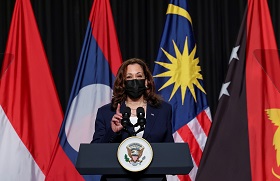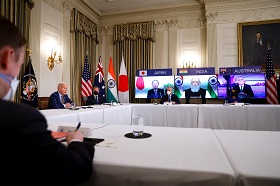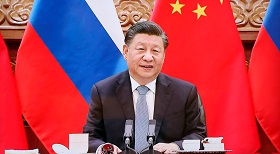Tokyo’s reaction to the aggravated international situation amid Russia’s special operation is extremely concerning. Sanctions were to be expected, as Tokyo has consistently followed suit with U.S. policy in this respect. However, the nature and extent of restrictions turned out to be far more significant than in 2014. That said, the energy and fuel sector has so far remained untouched.
It is disappointing that Japan refuses to treat economic cooperation outside the context of resolving the “territorial issue” and discuss a peace treaty until these claims are satisfied. Effectively, all the agreements reached by Vladimir Putin and Shinzo Abe in Singapore in 2018 were disavowed. The Eight-Point Cooperation Plan presented in Sochi in 2016, which—until recently—significantly contributed to the bilateral cooperation, will likely remain dormant, too. The negotiations between Minister for Foreign Affairs of Japan Yoshimasa Hayashi and Minister of Economic Development of the Russian Federation Maxim Reshetnikov held in February 2022 will probably also come to nothing. According to some unofficial reports, Japan does not consider it possible at the present juncture to continue trade, economic and investment cooperation.
For the first time, the Japanese government described Russia’s actions as “aggression.” In this regard, discussions on the need to amend Article 9 of Japan’s Constitution, which states that the country will never maintain armed forces or possess offensive weapons, have been stepped up. Other members of the parliament are gradually starting to support the initiative of the Japanese Communist Party to strengthen the country’s defence capabilities. The statement of Japan’s Ministry of Foreign Affairs on the Russian “occupation” of the southern part of the Kuril Islands, which, as the Japanese leadership has it, is a violation of international law, just like Russia’s “invasion” of Ukraine, is particularly telling. The return to such rhetoric is unlikely to facilitate bilateral cooperation.
In this regard, it is becoming increasingly likely that the push to increase defence spending that has all but been adopted as policy will be legitimized at the official level—the defence budget for 2022 totalled $47.2 billion and it could be increased by a further $6.8 billion. The additional spending is to purchase weapons and equipment that were not delivered due to the COVID-19 pandemic, as well as to implement protective measures to respond to threats from North Korea and China. Judging by what Japanese diplomats have been saying recently, Russia may also be included in the official list of the country’s enemies. Increasing funding to 2% of GDP (from the current 1.3%), as U.S. analysts have proposed, will ensure the further improvement of the Japan Self-Defense Forces in terms of technology and strike capabilities, which will change the balance of power in the Asia-Pacific forever.
Amid the incoming waves of restrictive measures imposed against Russia, Japan’s political establishment has come forward with a number of statements that may well push the country’s bilateral relations with Russia beyond the point of no return. The current economic, financial, technological, visa and other kinds of sanctions clearly demonstrate Tokyo’s commitment to the path charted by Washington and its allies. However, there have come to light some more dangerous trends—ones that could disrupt the fragile balance of power in the Asia-Pacific, causing a “wave” of instability with consequences that are difficult to predict.
Nuclear Communards
In late February 2022, former Prime Minister of Japan Shinzo Abe said on Fuji Television that—Japan’s participation as a non-nuclear state in the NPT Treaty and Tokyo’s own Three Non-Nuclear Principles notwithstanding—the country should think about enhancing its security, while refraining from seeing nuclear weapons as a no-go. Abe concluded that the Japanese government has repeatedly highlighted China’s growing military activity, as well as North Korea’s nuclear missile programme, to stress that the only feasible way to contain these threats could be through a joint nuclear mission (nuclear sharing) with the United States.
Within NATO, nuclear sharing provides for the deployment and storage of U.S. nuclear weapons in the territories of non-nuclear NATO member states. Today, U.S. tactical nuclear weapons (some 150 variable-yield B61 nuclear bombs) are deployed in Belgium, Germany, Italy, the Netherlands and Turkey, with all these nations (Turkey less so) being involved in training and planning exercises of nuclear strikes. However, the responsibility for the storage, control and command of these weapons lies with the U.S. Air Force, while it is solely Washington that decides when and to what extent they could be used.
Having enlisted support of such nations as Cuba, South Africa, Kazakhstan, Syria or the Philippines, the troika of Russia, China and Iran advocate a ban on the “horizontal proliferation” of nuclear weapons, which should include abandoning joint nuclear missions, as they go against the NPT. In a video address at the Conference on Disarmament in Geneva on March 1, 2022, Russia’s Minister of Foreign Affairs Sergey Lavrov noted that NATO’s joint nuclear missions are essentially exercises on possible strike scenarios against Russia. With this in mind, he stressed that all U.S. nuclear weapons should be returned back home in a swift manner, with the associated infrastructure in Europe destroyed.
Abe believes that Japan, having suffered the atomic bombings in 1945, endorses the notion of global nuclear disarmament—still, in the face of the escalating need to protect the lives of the country’s nationals, he argues it is worth considering other options to bolster security. He referred to the case of Ukraine, which agreed to transfer to Russia the nuclear weapons that remained in its territory following the collapse of the Soviet Union and which failed to obtain security guarantees.
The incumbent Prime Minister Fumio Kishida, whose family comes from Hiroshima, was forced to dismiss his predecessor’s dangerous train of thought. He conceded that the idea of sharing nuclear missiles with the United States would be unacceptable for Japan—at least, in terms of Prime Minister Eisaku Sato’s Three Non-Nuclear Principles proclaimed back in 1968 and approved by the parliament three years later. According to these principles, Tokyo will not possess, produce or allow the introduction of nuclear weapons into the country. China has been quick to demand that Tokyo uphold its commitment to renouncing nuclear weapons in any form.
We should not forget about the secret agreement concluded between Tokyo and Washington in the late 1960s—the very agreement that allowed the United States to place nuclear weapons on the island of Okinawa in emergency situations [1]. The global community only learned of it in 2005, and it is still impossible to say with any certainty whether the non-nuclear principles—more of a political statement rather than a binding obligation—were observed in practice.
Don’t Wake Up Godzilla!
In 2017, Shigeru Ishiba, former Secretary-General of the Liberal Democratic Party, spoke out in favour of Japan acquiring the technology to build nuclear weapons, should the need ever arise. Some experts suggest this would not be a formal violation of Japan’s Constitution. Still, there are doubts within the country’s political elite as to the effectiveness of U.S. “nuclear umbrella,” although the White House reaffirmed in April 2021 its commitment to ensuring Japanese security, using a full range of capabilities at its disposal, including nuclear weapons.
Over the years, Japan has accumulated some 45 tonnes of plutonium through the operation of its nuclear power plants, although only 9 tonnes are stored in the country, as the rest is temporarily held in the United Kingdom and France. The so-called MOX (mixed oxide) fuel, which includes plutonium produced in reactors, has yet to win popularity in the energy sector, as there remain certain difficulties in processing it. This creates uncertainty about the fate of the massive nuclear material, even if it is under IAEA safeguards. While many believe that Tokyo has the capacity to construct up to 6000 nuclear warheads, serious reprocessing is required to accomplish this—whether Japan has the technological capability to do this is open to debate.
Japan has the technology to produce missile delivery vehicles, including ASM-3 (with a range of 400km), JASSM and LRASM (both with a range of 500km) cruise missiles, which are already in service, as well as missile weapons currently under development, including hypersonic weapons. Early in 2021, the Japanese government announced its intention to extend the range of its land-, sea- and air-based cruise missiles to 1500km, with characteristics that boost the chances of a successful strike (low visibility, complex directory, variable cruise speed etc.). In addition, Japan’s industry has as good as perfected the technologies for producing ballistic missiles, with the most advanced model being the three-stage Epsilon-5 launch vehicle with a payload of more than 1200kg. The Japanese Aerospace Exploration Agency possesses remote sensing, telecom and reconnaissance satellites, while it could deploy interceptor spacecraft in the future [2].
When assessing Japan’s nuclear potential, the only unknowns are the true scale and rate at which the country could be producing special warheads for missiles and bombs, as well as the likelihood of such a decision being taken.
Considering Japan chooses to maintain its non-nuclear status, Tokyo’s military build-up endeavors still make one doubt the pacifism of the country’s leadership. Of particular concern for Russia (and China) are the acquisition of ground-attack capabilities with precision-guided missiles, the advancements in anti-missile defence systems, and the far from hypothetical deployment of U.S. intermediate- and shorter-range missiles on the Japanese soil. For example, the U.S. Marine Corps in Okinawa already has tactical missile systems capable of launching hypersonic missiles.
Island of Bad Luck
In his interview for Fuji Television, Shinzo Abe also touched upon the Taiwan issue. He believes the U.S. should give up on the concept of “strategic uncertainty” regarding military guarantees of the island’s security, as the only way to contain Beijing would be to make it absolutely clear—through an official statement—that Washington would be ready to intervene in the event of attack against Taiwan. The former Prime Minister noted that the island of Yonaguni, now part of Okinawa Prefecture, is only 110km from the Taiwanese coast, and Japan would lose control over the air and sea space here if China were to launch a military campaign. Early in 2022, Prime Minister Fumio Kishida spoke of the need to bolster the defences of the Nansei island chain, which separates the East China and Philippine seas, while being close to the island of Taiwan.
In August 2021, Tokyo and Taipei discussed the possibility of fostering more cooperation in trade, economy, investment and technologies as well as developing defence and security ties. According to the ruling parties of the two sides, the policy of the Chinese leadership demonstrates a clear intention to isolate the island, forcing its administration to cede its independence to a great extent and make it reliant on the mainland. In this regard, representatives of Japan’s Liberal Democratic Party did not rule out the possibility of Taiwan acceding to the Comprehensive and Progressive Agreement for Trans-Pacific Partnership in the near future, as well as its membership in intergovernmental international organizations, such as the World Health Organization.
Throughout 2021, Japanese politicians, including Deputy Prime Minister Taro Aso, openly spoke about the dangers for Japan of a possible Chinese military operation to return Taiwan and the need to help defend the island in the event of attack. For the first time ever, Japan’s annual defence report, delivered in July 2021, was unequivocal in stating the country’s stance on the Taiwan issue. A number of politicians have acknowledged that Japan’s Self-Defense Forces cannot repel Chinese aggression without the assistance of the U.S. Armed Forces. Naturally, such statements have not gone unnoticed in Beijing, where they have been described as absolutely unacceptable and dangerous. According to Zhao Lijian, spokesperson for the Chinese Foreign Ministry, Japan is wholly responsible for the “Taiwan issue” and must therefore be careful in what it says and does. Any attempt to support the Taiwanese “secessionists,” he stressed, would be regarded as interference in the internal affairs of the People’s Republic of China.
It is worth noting that the Joint Statement of the Russian Federation and the People’s Republic of China on the International Relations Entering a New Era and the Global Sustainable Development adopted in 2022 reflects Moscow’s unconditional support for the One-China principle. This should be understood as a recognition of Taiwan as an integral part of the People’s Republic of China, while some nations, at the behest of the United States, talk instead about a “united China,” avoiding any recognition of the sovereignty of the Communist authorities over the island. Incidentally, Taipei protested the joint statement and imposed sanctions against Russia in late February as the situation in Ukraine was developing.
Self-Defence has its limits
Finally, Tokyo’s reaction to the aggravated international situation amid Russia’s special operation is extremely concerning. Sanctions were to be expected, as Tokyo has consistently followed suit with U.S. policy in this respect. However, the nature and extent of restrictions turned out to be far more significant than in 2014. That said, the energy and fuel sector has so far remained untouched.
It is disappointing that Japan refuses to treat economic cooperation outside the context of resolving the “territorial issue” and discuss a peace treaty until these claims are satisfied. Effectively, all the agreements reached by Vladimir Putin and Shinzo Abe in Singapore in 2018 were disavowed. The Eight-Point Cooperation Plan presented in Sochi in 2016, which—until recently—significantly contributed to the bilateral cooperation, will likely remain dormant, too. The negotiations between Minister for Foreign Affairs of Japan Yoshimasa Hayashi and Minister of Economic Development of the Russian Federation Maxim Reshetnikov held in February 2022 will probably also come to nothing. According to some unofficial reports, Japan does not consider it possible at the present juncture to continue trade, economic and investment cooperation.
For the first time, the Japanese government described Russia’s actions as “aggression.” In this regard, discussions on the need to amend Article 9 of Japan’s Constitution, which states that the country will never maintain armed forces or possess offensive weapons, have been stepped up. Other members of the parliament are gradually starting to support the initiative of the Japanese Communist Party to strengthen the country’s defence capabilities. The statement of Japan’s Ministry of Foreign Affairs on the Russian “occupation” of the southern part of the Kuril Islands, which, as the Japanese leadership has it, is a violation of international law, just like Russia’s “invasion” of Ukraine, is particularly telling. The return to such rhetoric is unlikely to facilitate bilateral cooperation.
In this regard, it is becoming increasingly likely that the push to increase defence spending that has all but been adopted as policy will be legitimized at the official level—the defence budget for 2022 totalled $47.2 billion and it could be increased by a further $6.8 billion. The additional spending is to purchase weapons and equipment that were not delivered due to the COVID-19 pandemic, as well as to implement protective measures to respond to threats from North Korea and China. Judging by what Japanese diplomats have been saying recently, Russia may also be included in the official list of the country’s enemies. Increasing funding to 2% of GDP (from the current 1.3%), as U.S. analysts have proposed, will ensure the further improvement of the Japan Self-Defense Forces in terms of technology and strike capabilities, which will change the balance of power in the Asia-Pacific forever.
1. Yoshida F. (2018) From the Reality of a Nuclear Umbrella to a World without Nuclear Weapons: An Interview with Katsuya Okada // Journal for Peace and Nuclear Disarmament. Vol. 1, issue 2. – pp. 474–485.
2. Skosyrev V. Japan to Launch Killer Satellites // Nezavisimaya gazeta, September 18, 2019.







